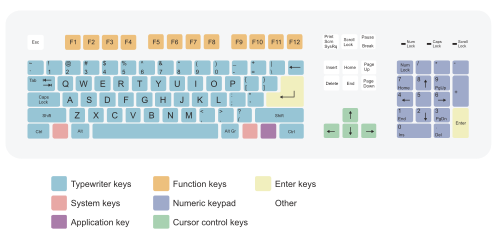Numeric keypad



A numeric keypad, number pad, numpad, or ten key, is the palm-sized, usually-17-key section of a standard computer keyboard, usually on the far right. It provides calculator-style efficiency for entering numbers.
The numpad's keys are digits
0 to9,+ (addition),- (subtraction),* (multiplication), and/ (division) symbols,. (decimal point),Num Lock, and↵ Enter keys. As smaller keyboards such as those found on laptops often lack a number pad, many companies sell separate numpads that can be connected to a device by means such as USB; some of these may include keys not found on a standard numpad, such as a spacebar or a00 (or000) key.Sometimes it is necessary to distinguish between a key on the numpad and an equivalent key elsewhere on the keyboard. For example, depending on the software in use, pressing the numpad's0 key may produce different results than pressing the alphanumeric0 key. In such cases, the numpad-specific key may be indicated as e.g.Numpad 0,NumPad0,Num 0, or likewise to remove ambiguity.
Numeric keypads usually operate in two modes. WhenNum Lock is off, keys8,6,2, and4 act like arrow/navigation keys up, right, down, and left; and7,9,3, and1 act likeHome,PgUp,PgDn, andEnd, respectively. WithNum Lock on, digit keys produce the corresponding digit. On Apple Macintosh computers, which lack aNum Lock key, the numeric keypad always produces only numbers; theNum Lock key is replaced by theClear key.
The arrangement of digits on numeric keypads with the7-8-9 keys two rows above the1-2-3 keys is derived from calculators and cash registers. It is notably different from the layout of telephone Touch-Tone keypads which have the1-2-3 keys on top and7-8-9 keys on the third row.
Numeric keypads are useful for entering long sequences of numbers quickly, such as in spreadsheets, financial/accounting programs, and calculators. Input in this style is similar to a calculator or adding machine.
A numeric keypad is also useful on Windows PCs for typing alt codes for special symbols; for example, the degree symbol, °, can be typed on these computers with the sequenceAlt+0+1+7+6.
To maintain their compact size, most laptops do not include a numeric keypad on their keyboard (though they can sometimes be found on larger models); even some desktop keyboards designed for compactness omit a numpad. To compensate, most such keyboards includeNum Lock integrated into a function key (typicallyF6 orF8) and then press keys like7 to produce their numpad counterpart.
Chinese input methods
The numeric keypad is used by some systems for input of Chinese characters, for example CKC Chinese Input System and Q9 input method.
Computer games and mousing alternative

Numeric keypads are also used for playing some older computer games where the player must control a character, such as roguelikes and Sid Meier's Pirates!. Unlike arrow keys, the numeric keypad can allow for diagonal movement. For keyboards without a numeric keypad, some games provide alternative movement keys, such as classic Rogue's HJKL keys.
The numeric keypad can also be an alternative to the WASD keys for navigation in computer gaming. This can be an attractive option for left-handed people who prefer to use the mouse with their left hand.
Most operating systems have a mouse keys accessibility feature where mouse navigation can be done using the numeric keypad, with the other keys adapted to be mouse buttons.
See also
Notes
References
| Esc | F1 | F2 | F3 | F4 | F5 | F6 | F7 | F8 | F9 | F10 | F11 | F12 | PrtScn/ SysRq | Scroll Lock | Pause/ Break | |||||||||
 | Insert | Home | PgUp | Num Lock | ∕ | ∗ | − | |||||||||||||||||
| Delete | End | PgDn | 7 | 8 | 9 | + | ||||||||||||||||||
| 4 | 5 | 6 | ||||||||||||||||||||||
| ↑ | 1 | 2 | 3 | Enter | ||||||||||||||||||||
| ← | ↓ | → | 0 Ins | . Del | ||||||||||||||||||||